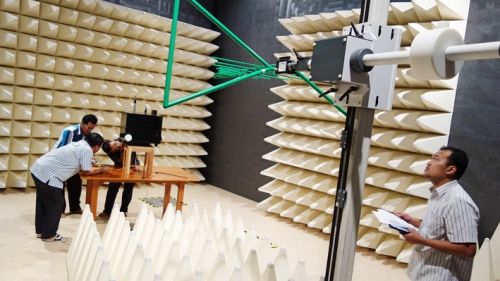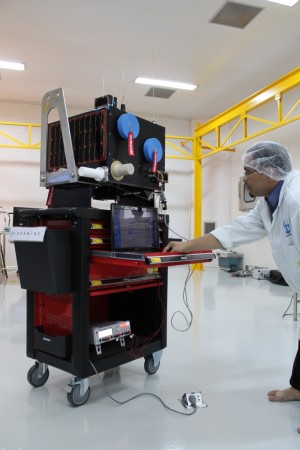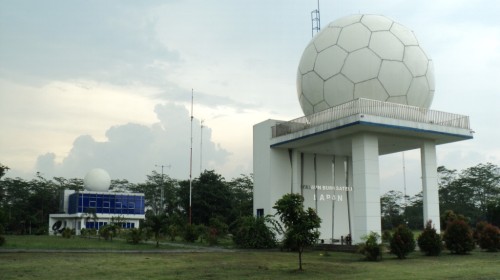
The Lapan-A2 microsatellite (the black box in the center) undergoes an electromagnetic compatibility test at the Center for Science and Technology (Puspiptek) in Serpong, Tangerang. (Photo courtesy of Lapan)
The bookish, bespectacled chief engineer of Indonesia’s first domestically made satellite briefly explains the six-year journey his team took before the satellite, called Lapan-A2, is ready for launch this year.
“It began in 2008, a year after we successfully launched Lapan-Tubsat, our first microsatellite, ” Mohammad Mukhayadi, of the National Aeronautics and Space Agency (Lapan), said at his office in Rancabungur, Bogor, last month.
“Then we started the development of Lapan-Tubsat’s successor. We call it Lapan-A2, and it’s finally complete.”
Lapan-Tubsat, also known as Lapan-A1, was built in Germany in an ambitious project that taught Indonesia the process of building satellites from scratch: how to procure components for production, how to arrange licenses and how to test the satellite until it is ready for launch.
Lapan-Lubsat was launched from the Indian space center in Sriharikota, in January 2007. Today, seven years after take-off, the satellite is still floating in space, though it began to slowly drift away from its orbit two years ago.
The 57-kilogram satellite continues to transmit earth surveillance video to Lapan ground stations, allowing operators to train themselves on satellite use and data retrieval methods, though the video data is barely of practical use.
“Of course, it is not what we would call operation qualified,” said Robertus Heru Triharjanto, the head of Lapan’s satellite bus technology division. “It is mostly for our own interest, to see how well we can produce pictures.”
He added Lapan will continue to monitor Lapan-A1 to study its degradation.
“We would like to see what seven years in space has done to the satellite; to collect data on which components are still healthy and which are not, and more importantly, why they came to that state.”
The Lapan-A2 is also a microsatellite, weighing 76 kilograms. Any satellite weighing between 10 and 100 kilograms is categorized as a microsatellite. Communication satellites like those used by Indonesian telecommunication firms Telkom and Indosat usually weigh more than a ton.
Indonesia has been purchasing its satellites for telecommunication purposes from other countries, as it has yet to effectively develop the capacity to manufacture its own satellites.
Lapan, with its Lapan A series of microsatellites — of which there will be five — are hoping to develop that capability.
“The goal of Lapan-A1 is capacity building,” Robertus said. “With the second satellite, we want to prove that we are capable of building a satellite. We want to show the public that we have learned from others and we are able to successfully apply our newfound knowledge in constructing a satellite on our own.”
Mukhayadi said he and his team spent two years designing the Lapan-A2 before procuring some components from Germany and producing the remaining components on their own.
The integration work began in 2011 and was completed in August 2012, along with the set of required tests. The integration was entirely done in Indonesia, making Lapan-A2 the country’s first self-designed, home-made satellite.
Lapan-A2, though, will have to wait until April or May before it can enter orbit, as Indonesia is still significantly behind in rocket technology. For a satellite to enter space, it must be launched with a launch vehicle or a carrier rocket.
Therefore, like its predecessor, Lapan-A2 will be launched with an Indian rocket as its “secondary payload”, with the primary payload being India’s first dedicated astronomy satellite Astrosat.
Mukhayadi said piggybacking as a secondary payload is “the cheapest” method, although that meant it would be highly dependant on the primary payload.
“When they’re [India] ready, we will launch our satellite,” he said. “But for now, the main payload is not ready.”
In the meantime, Mukhayadi and his team have been doing maintenance work on the Lapan-A2, regularly checking its “health”.
“The Lapan-A2’s construction is finished, every necessary component has been integrated, so the microsatellite is actually active,” Mukhayadi said.
He enthusiastically showed Jakarta Globe the carefully maintained microsatellite in his dust-free workshop at Lapan’s Satellite Technology Center in Rancabungur.
The black box doesn’t look much different from a household microwave but only slightly bigger.
He showed us the antennas that will be used to control the satellite from earth and to transmit data to earth; the star censor that will determine the satellite’s position in outer space and support its navigation; the solar panel to power the satellite; and the cameras that will be used to capture earth images.
Like Lapan-A1, Lapan-A2 is intended as an earth observation satellite, as opposed to deeper universe observation, which involves even more sophisticated and more expensive technology.
But Lapan-A2 will carry a digital camera, not just an analog video camera, allowing more practical use of data images.

A Lapan engineer performs maintenance on microsatellite Lapan-A2 at the space agency’s Satellite Technology Center in Rancabungur, Bogor. (Photo courtesy of Lapan)
Ultimately, Lapan hopes its satellites will be able to produce remote-sensing images that will help the country monitor its forest covering and forest fires, the span of its agricultural lands, to detect fish catchment areas and examine the condition of disaster-hit areas, among other uses.
Lapan until now has been obtaining such data from other countries’ satellites, which it has been allowed to access through leases or partnerships that otherwise require regular payments of money.
Other than the digital camera, Lapan-A2 will carry two additional payloads, namely the Automatic Identification System (AIS) for ship surveillance — to help monitor maritime traffic in Indonesia — and a text message repeater for the Indonesian Amateur Radio Organization (Orari) for disaster mitigation purposes, which explains the satellite’s other name, Lapan-Orari.
Mukhayadi also showed two sets of components that he said were exact copies of Lapan-A1 and Lapan-A2’s interiors.
“If there’s a problem with the satellites in orbit, we can conduct a test and simulation with devices on the ground,” he said.
For the next satellite, Lapan-A3, the agency will partner with the Bogor Institute of Agriculture (IPB) to develop a payload for agricultural purposes. Robertus said Lapan was also planning to install a magnetometer in the satellite, which will allow the monitoring of solar activities, Lapan’s first attempt to probe the world beyond our earth.
LapanA3’s integration is set for completion next year. The total production cost of the satellite is slightly higher than that of Lapan-A2, at approximately $3.5 million, Robertus said. Lapan-A1 had cost $1 million to make.
Lapan-A4 is projected to be built in 2016, and Lapan-A5 in 2017.
The development of a B series, for remote-sensing satellites, and C series, for communication satellites, has been scheduled to commence in 2018.
The plan is according to Lapan’s satellite development roadmap, drafted before the House of Representatives passed the Space Law in July. After the law’s issuance, the agency has expressed high hopes to accelerate its implementation.
A new arm: Space Law
Indonesian lawmakers may have failed to explain to the public the significance of the new space law, the aspects of which are quite esoteric.
Sutan Bhatoegana, the head of the House of Representatives’ Commission VII on energy and technology, which dealt intensively with the bill before it was passed into law, cryptically explained that it —the new space law — “has to do with satellites, which are important for communication. ”
But the law is much more than that.
It mandates Lapan to develop satellite and rocket technology, to carry out peaceful uses of such technology, and it mandates the government to pursue bilateral or international cooperation that will enable a transfer of technology.
The law regulates the construction of a space port, investigation of space-related accidents (including space debris or meteorites falling within Indonesia’s territory), and partnerships with the private sector.
It paves the foundation for a space industry in a country that has been moving at slower than a snail’s pace in its space sector, despite the establishment of the agency 50 years ago. Lapan was set up in 1963, under Indonesia’s first president, Sukarno.
“The government and the House might have deemed [the space sector] too high a technology, while there have been many other things they still need to take care of,” Agus Hidayat, the head of Lapan’s cooperation and public relations bureau, said at the agency’s headquarters in Jakarta.
“But the birth of this law has been fully supported by the House. I guess now the government and the House are at the same frequency. At least their awareness of the sector is becoming more concrete.”
One “concrete” evidence is a budget increase of at least Rp 310 billion ($25.4 million) for 2014, Agus said, and that is more than half the Rp 526 billion amount disbursed to Lapan last year.
The 2013 figure represents only modest increases from Rp 493 billion in 2012 and Rp 466.8 billion in 2011.
The Space Law, though, specifies no sanctions for failure to carry out the aforementioned mandates, so implementation will likely depend heavily on the House.
Agus, though, is confident that the House is committed to developing the space sector, viewing their passage of the law as evidence.
“It is the House’s task to oversee law implementations. So, if they ask us why we fail to develop this or that, we can easily counter, ‘Where’s the money?’ ” Agus said.
“They can’t demand us to build an aircraft if they only give us a budget for a bajaj [three-wheeled car]. If they ensure a smooth flow of our funding, surely we’ll also be able to work smoothly.”
Agus added Lapan was currently drafting a master plan for Indonesia’s space industry development for the next 25 years, which is another mandate of the law.
He envisions the industry, which includes heightened roles for Lapan and extensive involvement of the private sector, to be in existence five years from now.
Robertus, though, thinks it needs at least 10 years for the industry to develop, taking into account the need to build the workforce that will run the industry.
“If we look at the experience of other nations like China or India, usually it takes more than 10 years for the space industry to establish a solid [legal] ground,” Robertus commented.
He envisioned Indonesia to become Asia’s next big space player in that 10-year span — after Japan, China, and India.
“If the new space law can be implemented according to the plan, we are sure to have a good, promising future,” Robertus predicted.
But Hakim L. Malasan, of the School of Astronomy at Bandung Institute of Technology (ITB), highlighted the law’s failure to address the human resources need to support the industry.
“I haven’t seen this law guarantee the development of top human resources in the fields of astronomy and astrophysics, though they will be important for Indonesia’s space industry,” said Hakim, also a vice president of Paris-based International Astronomical Union.
“Clauses on education and the development of relevant educational institutions to train future astrophysicists should have been incorporated in the law.”
He added, nevertheless, that Lapan was already on the right track by learning everything from the ground up, in order to end Indonesia’s reliance on other countries’ space products.
“A classic problem with Indonesia is the lack of will to start from the bottom and develop things from scratch using science. We tend to enjoy being consumers of foreign products,” Hakim said.
“I see that Lapan is already on the right track. It only has to move faster in order to accomplish its roadmap.”
China deal, space war concerns
Just a few months after the passage of the Space Law, Indonesia inked in October a partnership deal with China on “the development of space technology for commercial and peaceful purposes”.
The new cooperation also brings hopes to Indonesia’s space sector.
“Why are we interested in China? Because they’re still quite open,” Agus said. “China is probably willing to share a bit of rocket science with us.”
Developing rockets that will launch satellites to outer space is even more difficult and complex than manufacturing the satellites, Agus said.
While Indonesia’s slow satellite technology development is largely attributable to the nation’s lack of commitment to the sector — and thus the lack of funding — for the development of rockets technology there is another, more “sensitive” issue.
“Rocket technology is very different from aircraft and satellite technology. For the latter, other countries are very open, we can learn from them, we can ask them how to make one,” Agus said.
“As for rockets? No way. Developed countries don’t want Indonesia to be advanced in rocket technology because they worry we’ll use it to develop weapons.”
Indonesia, Agus said, really had to start from zero, all on its own, with regards to rocket technology.
The latest rocket Lapan launched in its rocket test center at Pameungpeuk beach in Garut, West Java, only had a range of between 100 and 200 kilometers, less than a third needed for the minimum height of a satellite in orbit, which is around 600 kilometers. Large communication satellites need to be placed even farther: in the geostationary orbit, a circular orbit around 36,000 kilometers above the earth’s equator.
“To be frank, we’ll be very slow in rocket development,” Agus said.
Negotiations with China concerning detailed schemes of the partnership, though, are still underway.
China has so far asked to be allowed to build a ground station in Pare-pare, a port town in Indonesia’s South Sulawesi province, where a Lapan station is also located.
Agus said China needed the station to track its newly launched satellites.
Indonesia, though, has not agreed on anything. “We’re still negotiating. What can we get in return? It’s not good if they get more from us.”
Agus added Indonesia treaded carefully in any space negotiation with another country, citing a perceived space war involving the US and China, in which each country has reportedly been developing their own anti-satellite weapons.
The US especially, according to a Reuters report in May last year, has remained concerned about China’s development of its anti-satellite capacity after Beijing shot its own defunct weather satellite in 2007, creating a multitude of space debris. The action caused protests from nations worldwide because of the potential harm the space debris may cause to their respective operating satellites.
In the following year, the US shot its non-functioning intelligence satellite while it was entering the earth’s atmosphere.
Mukhayadi said during the six years of Lapan-A1’s operations, Lapan has received three or four alerts on near collision with space debris, although all of them were easily avoided with a small amount of maneuvering commanded by Lapan’s ground stations.
Indonesia doesn’t want to be dragged into the “new frontier” competitions, directly or not. The Space Law appears to have anticipated this, banning any space activities for non-peaceful purposes, although again it fails to offer sanctions.
“Surely we have concerns about this issue, which is why we need to be very careful with this law. We can no longer simply accept an offer as it is,” Agus said.
“That’s why negotiations with China have been quite difficult. We don’t want to be dictated.”
Agus added that in addition to China, Russia and India have also quite aggressively approached Indonesia, offering space cooperation.
He said they were particularly interested in the archipelago’s geographical advantage, specifically its position under the geostationary orbit (GSO). An object put in this orbit will appear stationery relative to the rotating earth, and holds most of the world’s communication and weather satellites in orbit.
“GSO is the sexiest site to place satellites, particularly communication satellites, because gravity is almost zero there, which means the energy needed to maintain satellites [in GSO] is smaller than in the orbits beneath,” Agus said. “Our GSO territory is very long compared with other nations, equal with Brazil.”
Indonesia recently decided to reject Russia’s offer to build an air launch in Biak, Papua, citing local residents’ rejection and safety reasons. In the past few years, Russia had been offering Indonesia a partnership that will use the new technology — launching satellites off a flying aircraft rather than a ground launchpad.
And although the US has remained silent about all those other growing space nations’ — especially China’s — moves to approach Indonesia, Agus said he believed the US is keeping a close watch.
“I’m sure they’ve been doing that silently, albeit never explicitly.”
National pride, or financial gain?
In the end, this is not about national pride, Agus said, though he proudly claimed Indonesia was quite advanced in its satellite technology compared with its Southeast Asian neighbors.
“If you talk about a manned mission, or lunar or Mars exploration, I think those are more about prestige; to show other nations that they are now inferior,” Agus said. “But our need is real, especially with regards to earth observation.”
He said Indonesia wishes to build its own ground stations, to operate its own satellites, to end its reliance on other nations such as the US and France, from which the country has been “renting” satellites to gain access to crucial earth observation data.
China and India have also been offering to sell such data to Indonesia, while Singapore is developing commercial satellites for a similar purpose, Agus said.
“Once we have mastered earth observation, at least we can end that reliance. So, this is not about prestige; we really need that [independence]. ”
It doesn’t hurt, though, to consider China’s offer for a manned mission, Agus added. He said sending an astronaut to outer space would likely be incorporated in Lapan’s 25-year master plan.
Indonesia almost had its first astronaut when microbiologist Pratiwi Sudarmono, now 61, was selected in 1985 to take part in a NASA space shuttle mission as a payload specialist.
The mission was cancelled, though, after NASA’s space shuttle Challenger, which was supposed to carry Pratiwi to space, exploded before her scheduled mission in 1986. Pratiwi has since then been focusing on her academic career. She is now a microbiology professor at the University of Indonesia.
But before Indonesia can make up its mind whether launching a manned mission is necessary, this year the country will finally have its first astronaut in the outer space anyway.
Rizman A. Nugraha, a 24-year-old web designer, is among 23 people from around the world selected in December to board shuttle spaces under Axe Apollo Space Academy, which is sponsored by consumer goods giant Unilever.
Rizman, who has been undergoing training at the Kennedy Space Center in Florida, will board a two-seated space shuttle called the XCOR Lynx Mark II, with a pilot.
— Additional reporting by Benjamin Soloway
The original story was published in Jakarta Globe on Jan. 7, 2014.


